I am from Kashmir in Northern India. In 2005 we had a 7.5 magnitude earthquake and some 80,000 people died, while 2.8 million were displaced. I was 17 when it happened. Ever since then, I have devoted my time, my efforts, my career to figuring out engineering solutions during times of natural disasters. After studying civil engineering in India I came to Stanford for my master’s and PhD.
In 2014 I went back to Kashmir to get engaged. The day I arrived there was a flood. About 85 percent of Kashmir was under water, with some homes submerged up to three floors. It happened quickly. I was one of the lucky ones, in the right place at the right time. Most of my family and friends were stranded. Some people died of hunger. After the fifth day houses started collapsing because of the water pressure, which they aren’t designed to withstand. During this time there were 10 or 20 helicopters dispatched to rescue people. Two million people were calling for help.
On my flight back to the U.S. I began thinking about this problem. How do emergency response units prioritize their rescue efforts? Is it random? It’s not that responders don’t want to rescue the people who need it most, it’s just that they have limited situational awareness. That’s when I wondered if we could use data-driven, scientific methods to figure out who needs to be rescued. Then another incident occurred that furthered this idea. The day I arrived back in California, I heard that there had been a 6 magnitude earthquake in Napa. It wasn’t a big deal, but I was curious about it because I’m an earthquake engineer. I read online that there wasn’t much damage, but I did learn that tens of thousands of 911 calls were made in the first few minutes it hit. And the responders go on a first-come, first-served basis. It took them several days to reach the last person. Then I found out that the majority of the calls weren’t even from the worst affected areas in Napa County, because the network was down there. It hit me: ‘Wait a second – the responders were not even using their resources on those most critically in need!’ This was the same problem that Kashmir had during the flood. That is when I knew I needed to address this problem through research.
At the end of my class CS 229: Machine Learning there was a poster presentation. Professor Andrew Ng walks by my poster and asks, ‘What is this map?’ I respond, ‘This is the map for building damage after the Loma Prieta earthquake. Building inspectors went house-by-house and tagged the buildings. It took them a year. This is the same map, but we predicted it in three minutes.’ I had taken machine learning and combined it with historical data of models of how buildings have reacted to earthquakes in the past. The output are predictions that are available live and at scale.
We took our idea to an emergency operation center in San Francisco. Their job is to manage the movement of police, paramedics, and firefighters. They didn’t believe us when we showed them our prediction tool. ‘This is magic. It will change the way we have been working for the past 30 years.
Related spotlights

Lara Weed

Sebastian Fernández

